Body art can be anything you imagine. However, tie dye tattoos stand out for their vibrant colors and intricate patterns. Just like 1960s tie-dye shirts, these tattoos blend colors in swirls that pop on the skin.
Tie-dye tattoos aren’t just splashes of color. They mix art and skill. A great tie-dye tattoo looks like a tiny rainbow vortex. Only a skilled artist can make those smooth blends and perfect loops.
In this post, we’ll explore tie-dye tattoos step by step:
- History and Origins
- Artistic Techniques
- Symbolism and Meaning
- Choosing the Right Artist
- Aftercare Tips
Whether it’s your first tie-dye tattoo or you want more color in your life, tie-dye art on your skin is a fun, bold choice. Let those bright swirls show off your unique style and free spirit!
Tie-Dye Tattoos: Origins
Tie-dye started long ago when people dyed cloth by folding, twisting, or bunching it. They tied it, then added bright dyes. This made unique, colorful patterns. In the 1960s, tie-dye became a symbol of peace, music festivals, and a free spirit.
Now, artists often incorporate tie-dye ideas into tattoos. These bold, colorful tattoos are ideal for anyone who wants to make a statement.
Design Tips
- Color Choices:
- Primary Colors: Red, blue, and yellow make a bold look.
- Pastels: Soft pinks, blues, and greens give a gentle, faded style.
- Rainbow: All colors blend for a fun, hypnotic effect.
- Pattern Styles:
- Spirals: Classic tie-dye swirls that feel lively.
- Mandalas: Circle designs mixed with bright colors for a magical look.
- Abstract: Free-form shapes let you make a one-of-a-kind tattoo.
- Where to Put It:
- Significant Areas: The back, thighs, or upper arms provide ample space for large art.
- Small Spots: The wrist, ankle, or behind-the-ear area works well for tiny tie-dye designs.
Tie-dye tattoos require planning and the expertise of a skilled artist. With the right colors, pattern, and spot, your tattoo will shine like a real tie-dye shirt!
Application Techniques
Creating a tie-dye look with tattoo ink is more complicated than doing it on fabric. Tattoo artists employ specialized techniques to achieve the perfect color balance. Let’s look at how they do it.
Color Layers
- First Light Colors: Artists typically start with light colors. This makes a good base.
- Adding Dark Colors: Then, they add darker colors on top. These mix well with the base to create cool new shades.
- Blending Smoothly: The colors must flow into each other without sharp lines. That makes it look soft and natural.
- Shading Tricks: Artists use shading to make smooth color fades, also called gradients.
Small Details
- White Highlights: Tiny white spots can make the tattoo appear to have folds or shine.
- Thin Lines: Fine lines add detail and help the design look real and bright.
How to Care for a Tie-Dye Tattoo
Taking care of your tattoo is super important. It helps the colors stay bright and last longer.
Right After You Get It
- Clean Gently: Wash the tattoo with mild soap and warm (not hot) water.
- Keep It Moist: Use a small amount of tattoo-safe lotion to prevent it from drying out.
- Cover It Up: For the first few hours, keep the tattoo wrapped in a clean bandage. This keeps germs out.
Long-Term Care
- Stay Out of the Sun: Too much sunlight can make your tattoo fade. Try to keep it covered when you’re outside.
- Keep Using Lotion: Keep your skin soft by using lotion often. This helps the colors stay bright.
- Get a Touch-Up If Needed: Over time, the colors might fade. A touch-up by your artist can bring it back to life.
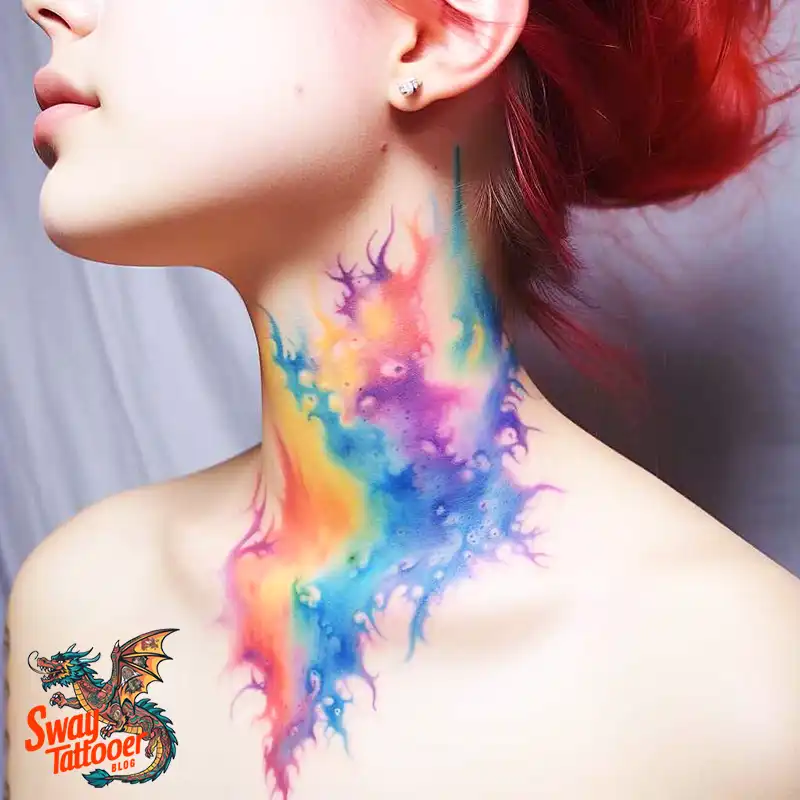
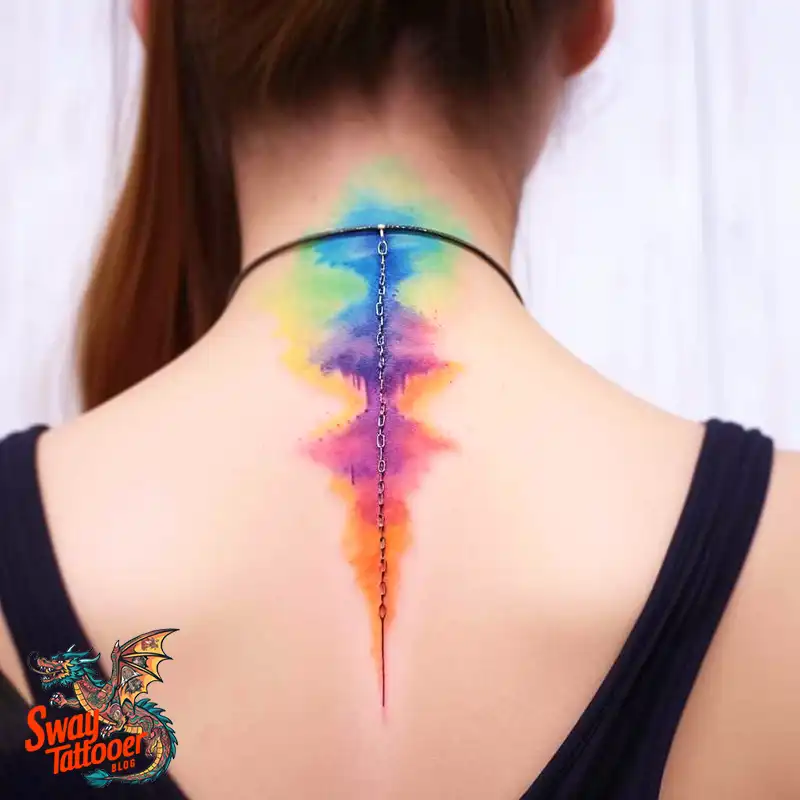

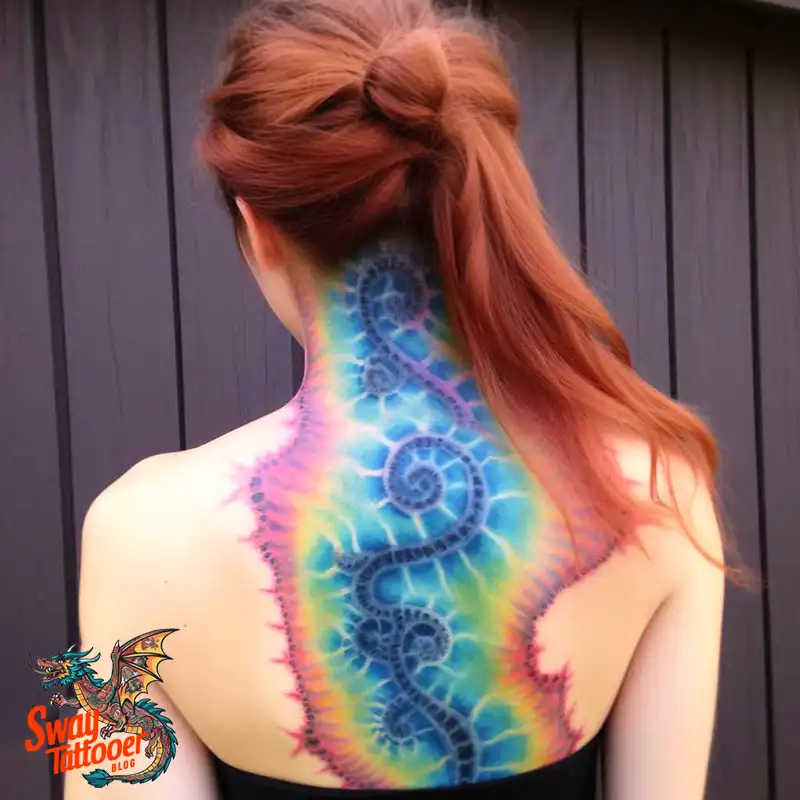
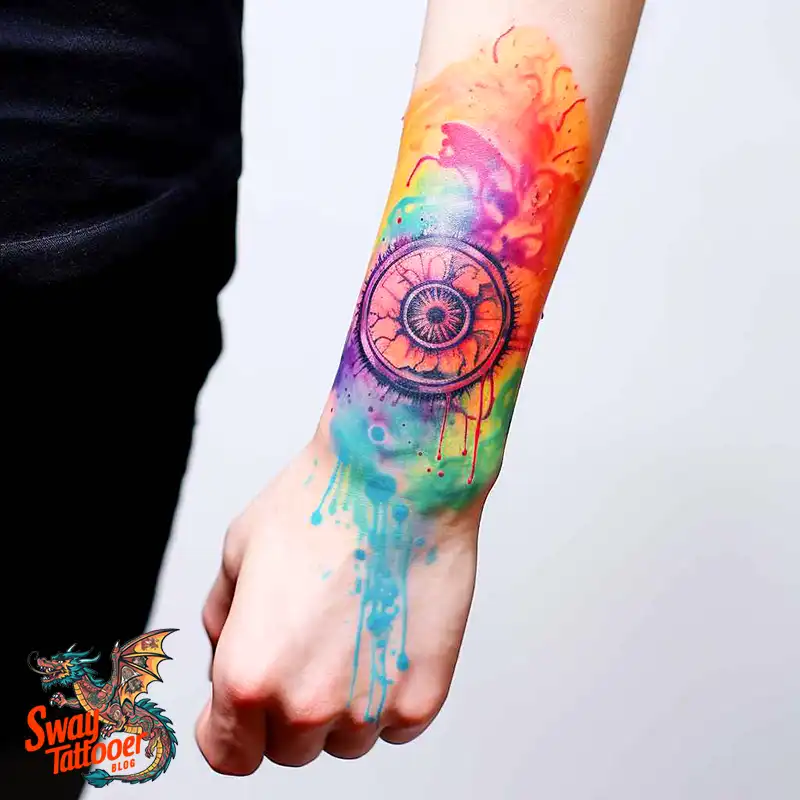
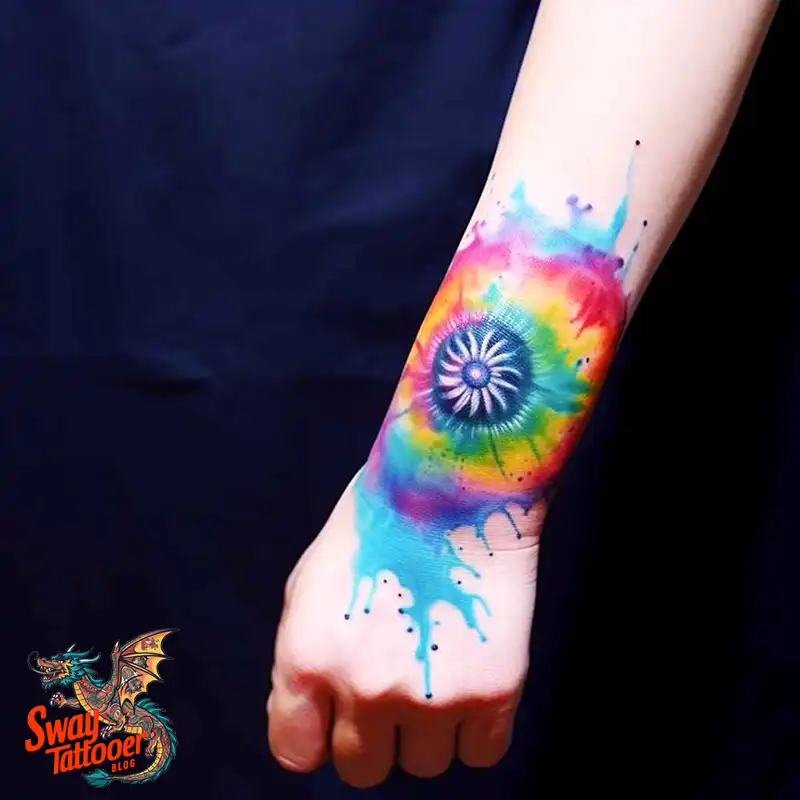
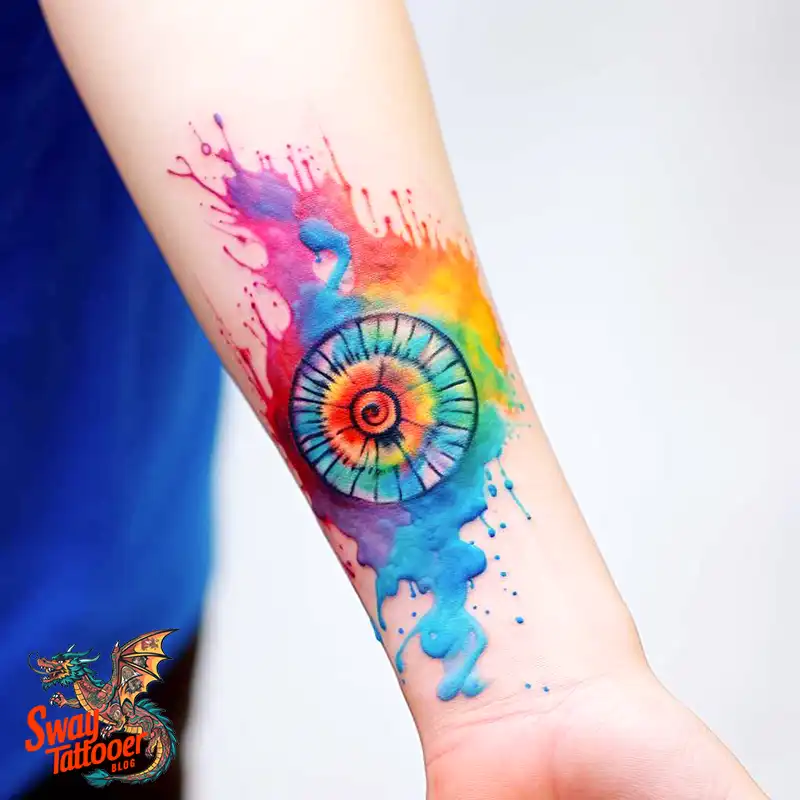
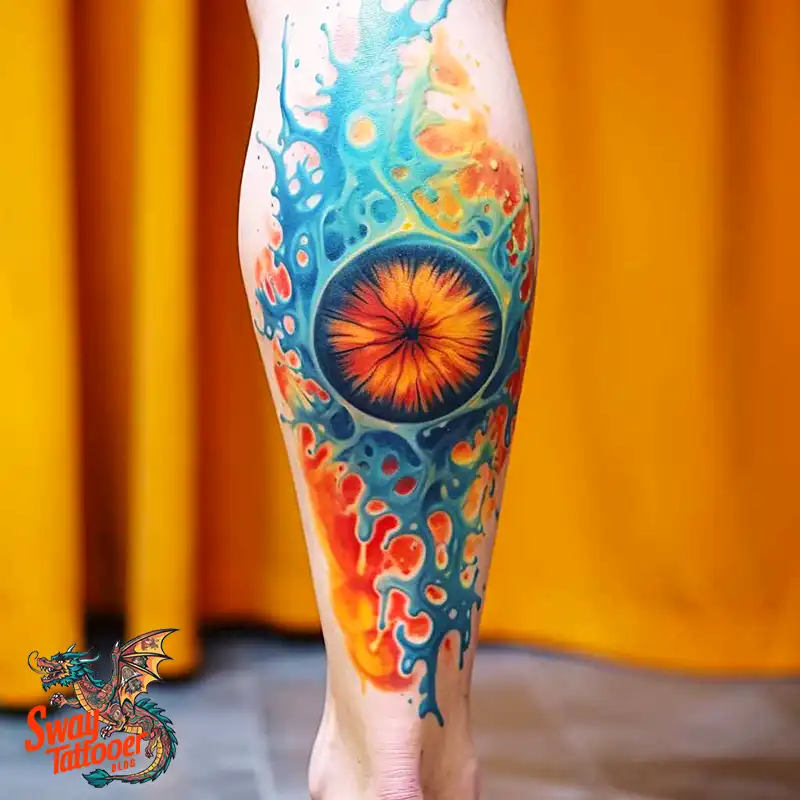
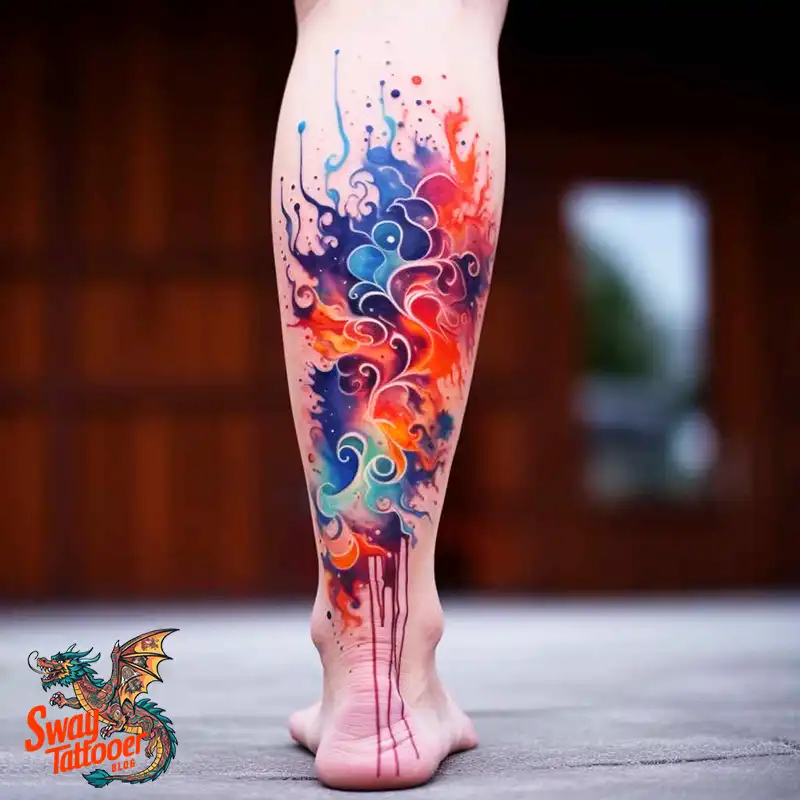
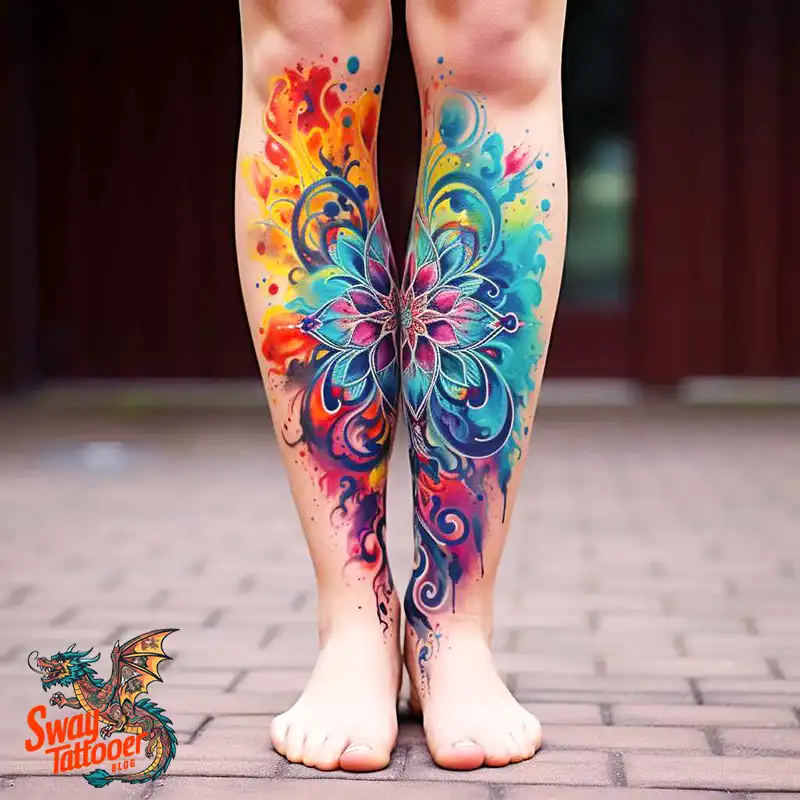
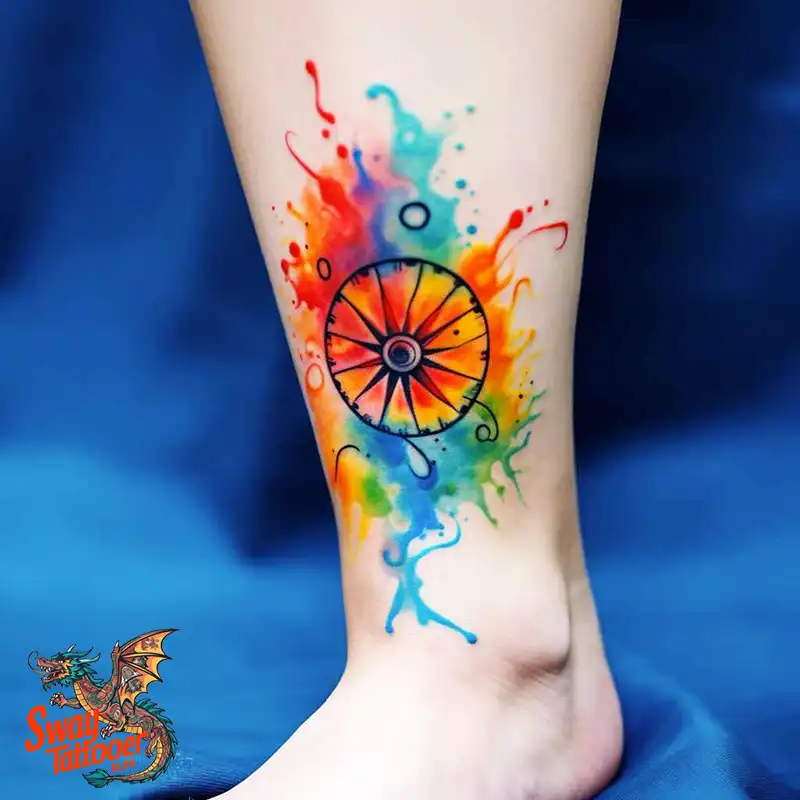
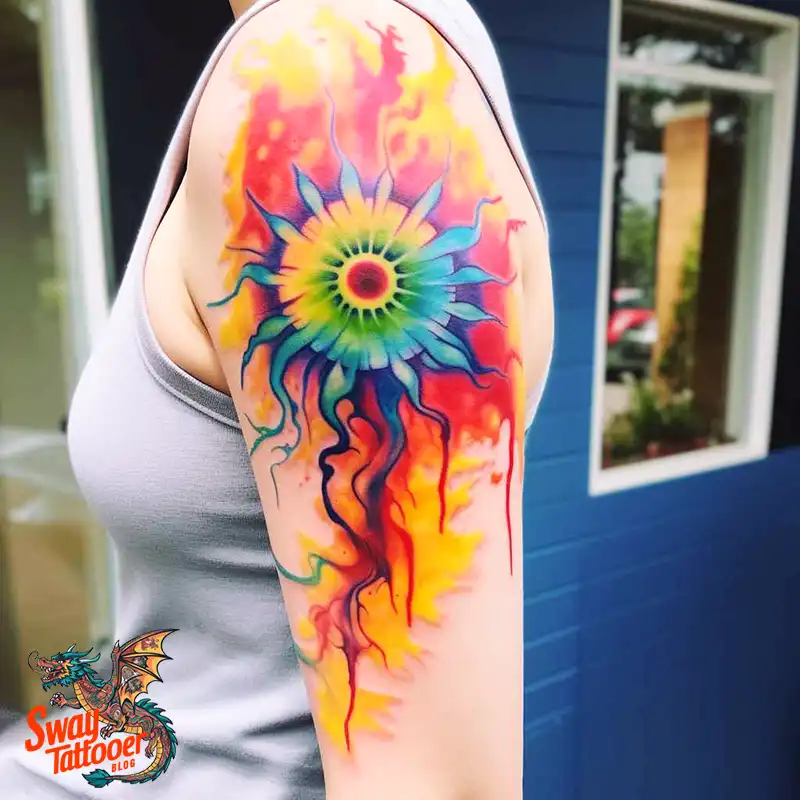
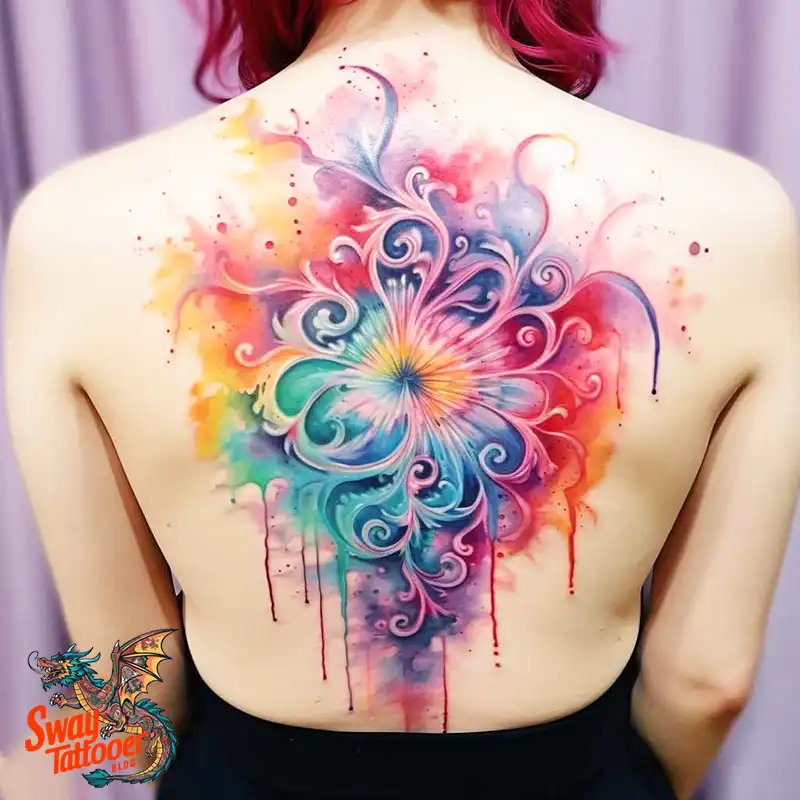
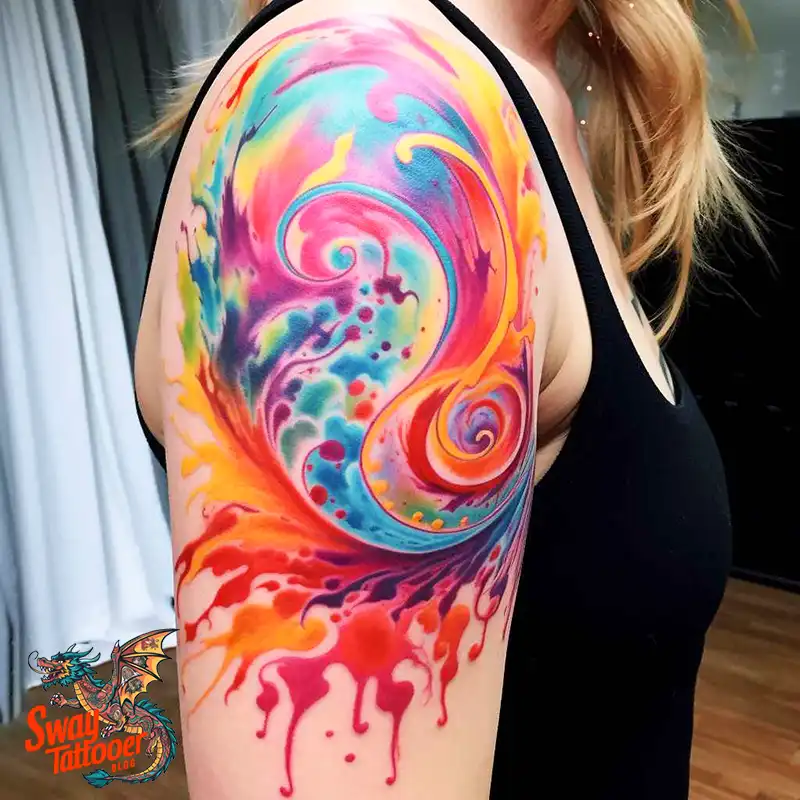
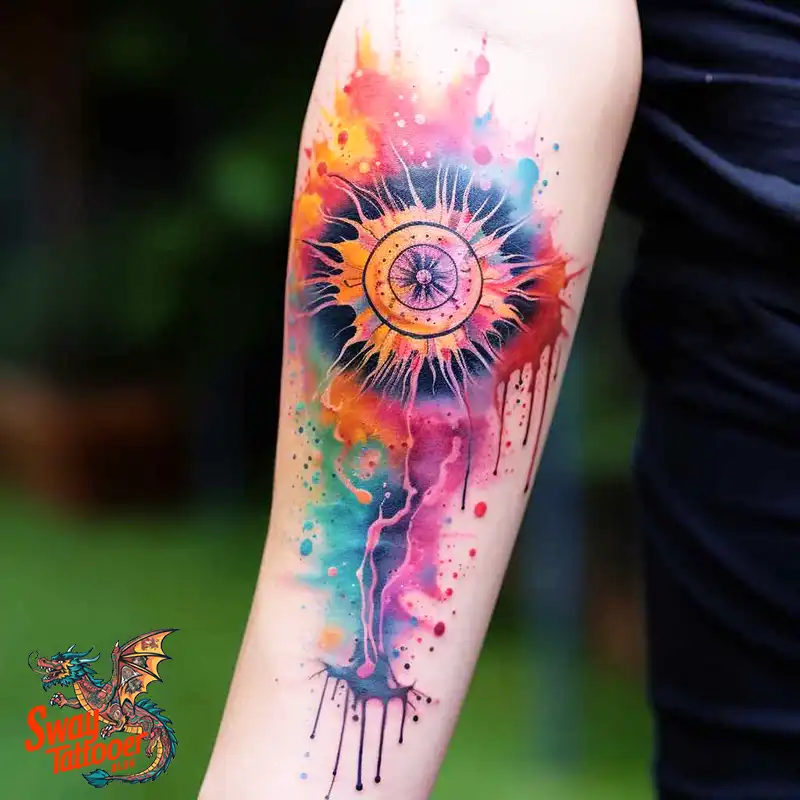
Choosing the Perfect Artist
Tie-dye tattoos are tricky. They take skill and practice to get right. So, choosing the right tattoo artist is super important. Here are a few tips to help:
- Check Their Work: Look at their past tattoos. Select someone who has created numerous bright and detailed designs.
- Find Experience: Choose an artist who knows how to do tie-dye tattoos or something close.
- Talk First: Meet the artist before getting inked. Ensure they understand exactly what you want.
A tie-dye tattoo requires planning, meticulous work, and proper care after it’s completed. These tattoos are full of color and fun. They need an artist who can handle all the steps. Whether you love the wild spirit of tie-dye or just the swirly colors, this kind of tattoo is a bold choice. It’s a big decision, so take your time. Consider the style, where you want it, and how it will be executed.
Types of Tie-Dye Tattoos:
Tie-dye tattoos are bright and bold. They are reminiscent of tie-dye clothes, full of color and fun shapes. Let’s look at some popular styles and what they stand for:
1. Traditional Spiral Tie-Dye
What It Is:
This design looks like the classic tie-dye swirl. Many colors spin out from the center in a spiral. It feels like a burst of motion and energy.
What It Means:
This pattern is famous from the 1960s. It stands for freedom, fun, and being yourself. It also shows personal growth and change. People who love this style often enjoy art, music, and peace.
2. Mandala Tie-Dye
What It Is:
This type of tattoo combines tie-dye colors with intricate shapes, such as flowers and stars. It utilizes symmetry, which means both sides are mirror images of each other.
What It Means:
The mandala is a spiritual symbol in some cultures, like Hinduism and Buddhism. It stands for balance and the universe. When mixed with tie-dye, it can show calmness and self-discovery. It’s an excellent choice for people who meditate or want a peaceful design.
3. Watercolor Tie-Dye
What It Is:
These tattoos look like watercolor paintings. The colors blend seamlessly into one another. The designs can be random or clear shapes.
What It Means:
These tattoos look like art on your skin. They’re great for people who love painting or want something soft and creative. Watercolor tie-dye tattoos show beauty in imperfection and are perfect for anyone who loves unique, artsy designs.
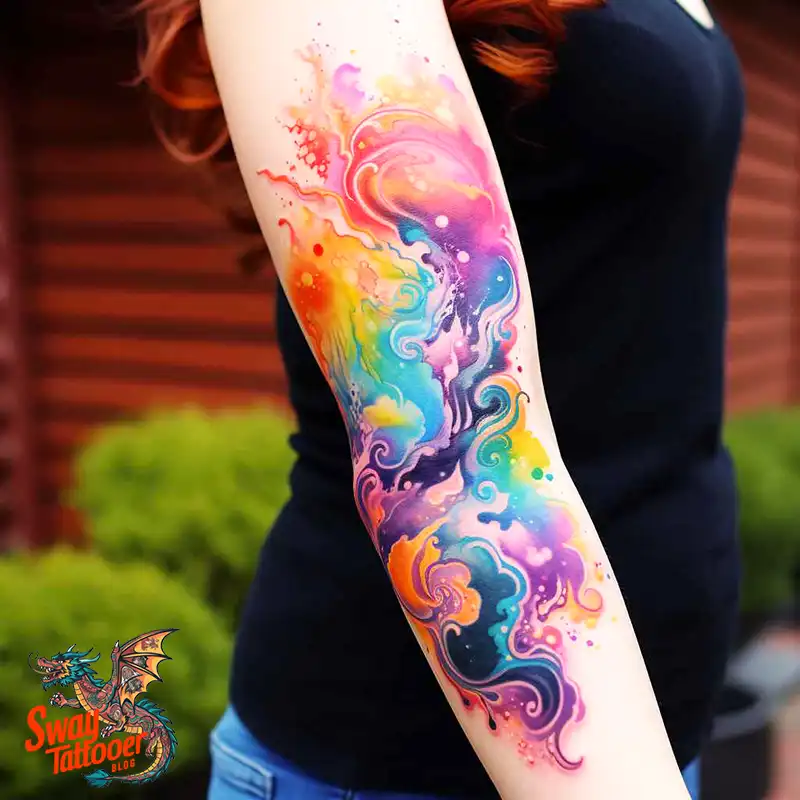
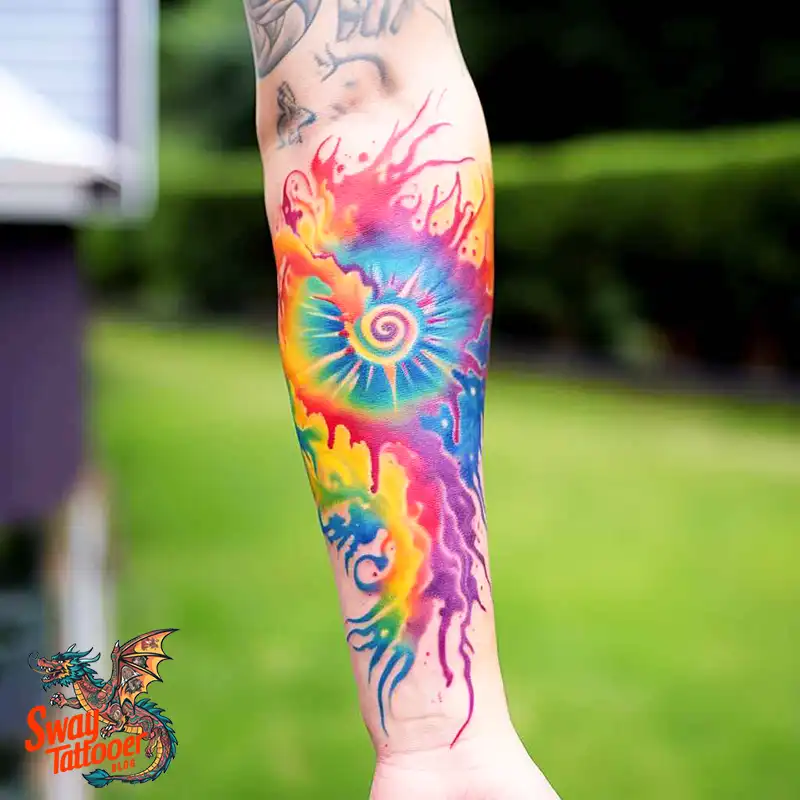
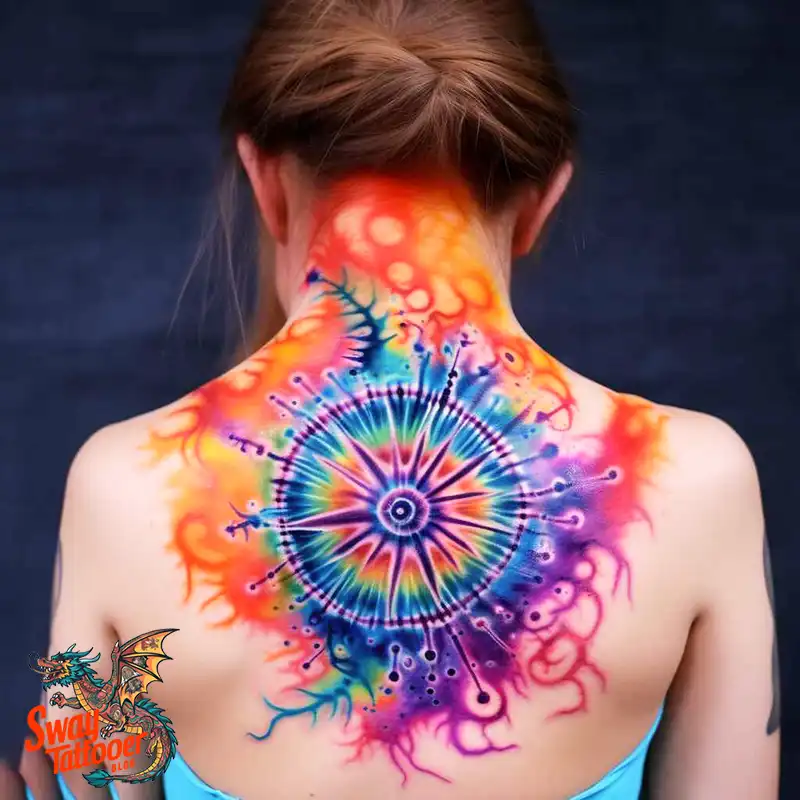
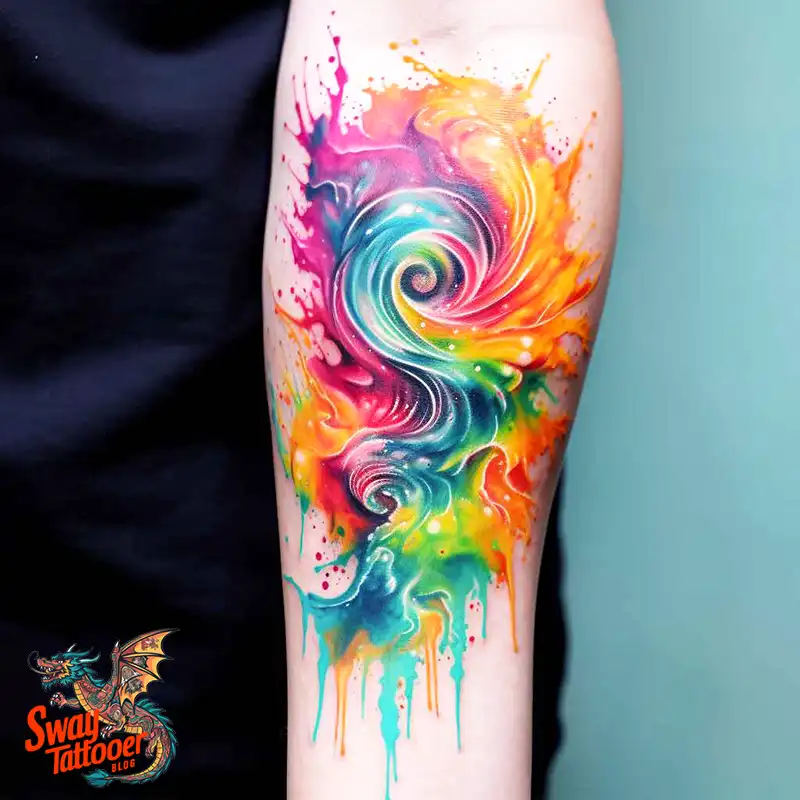
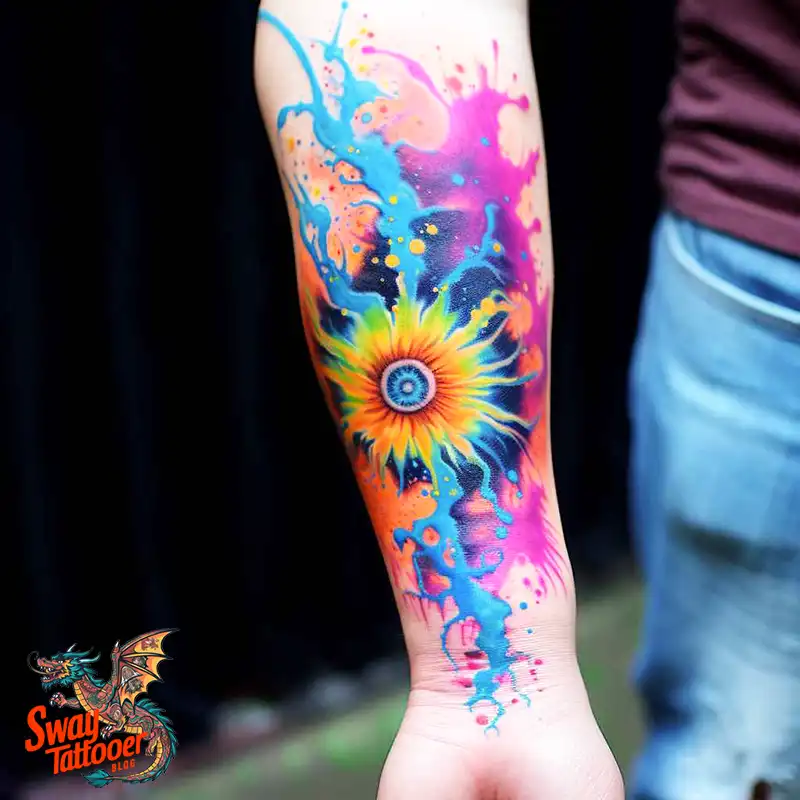
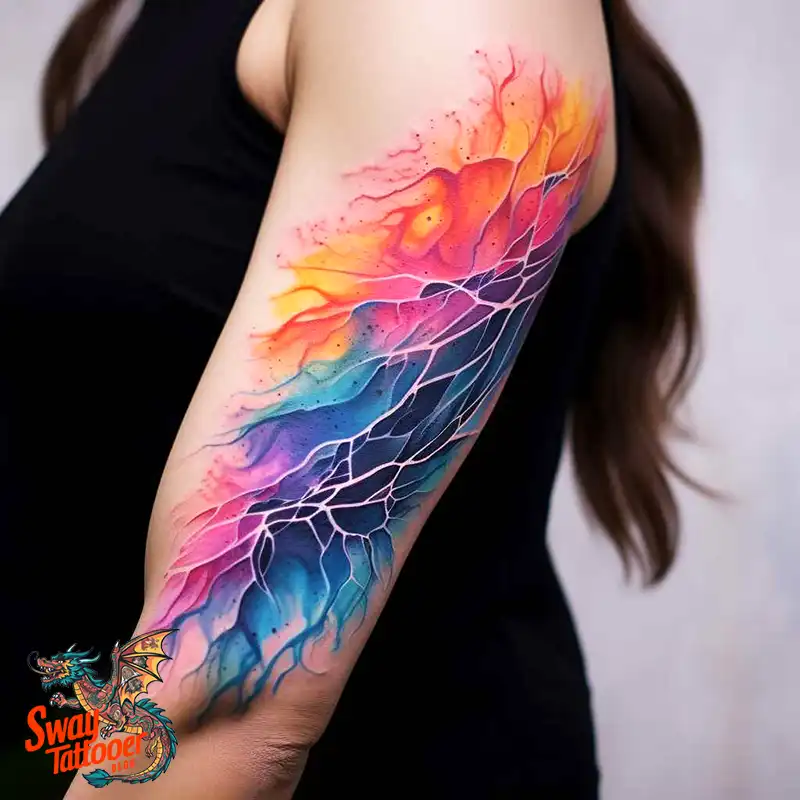
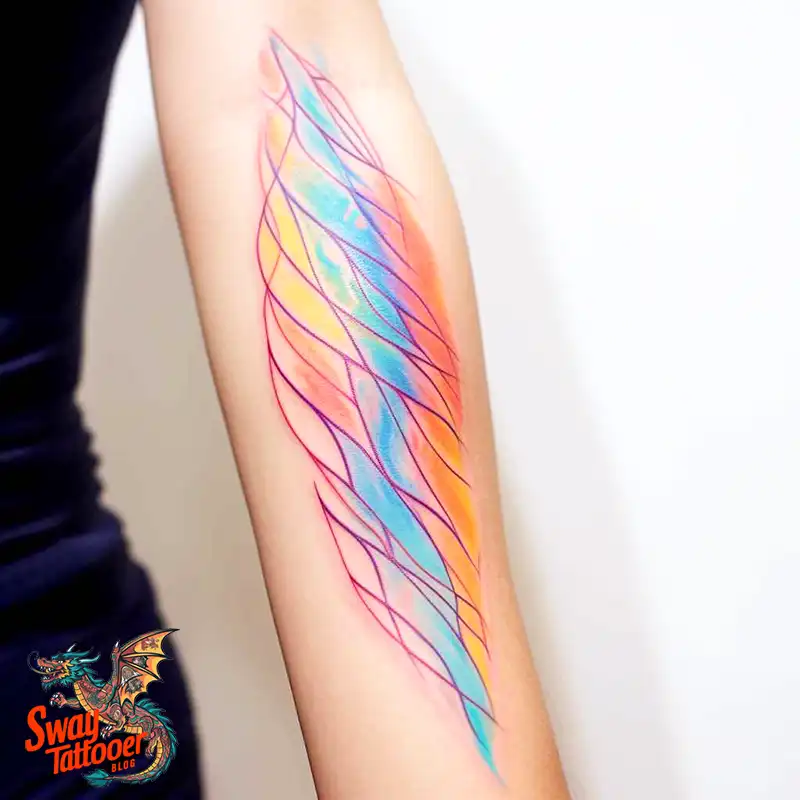
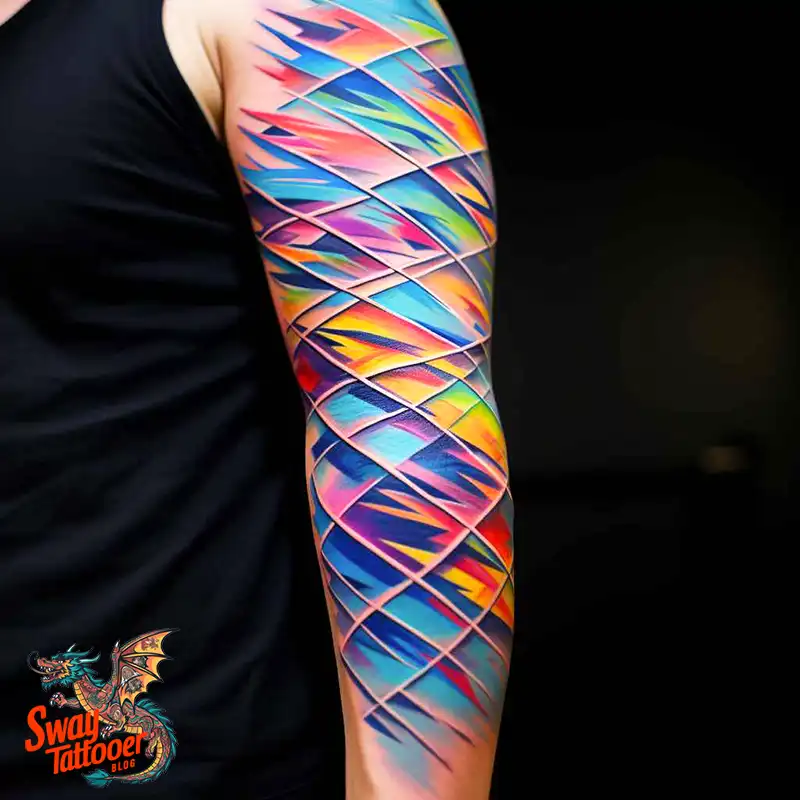
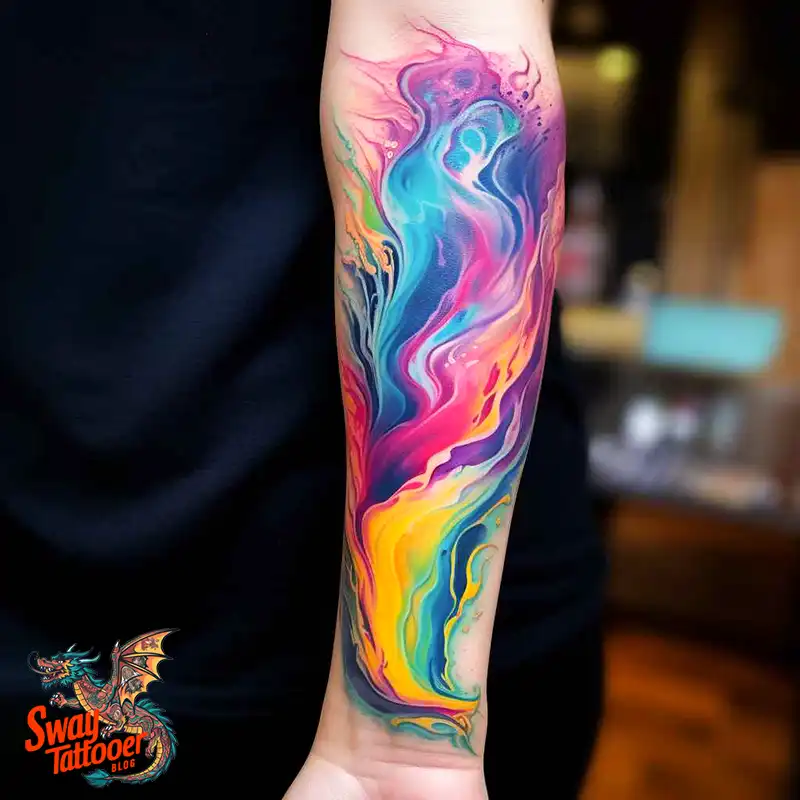
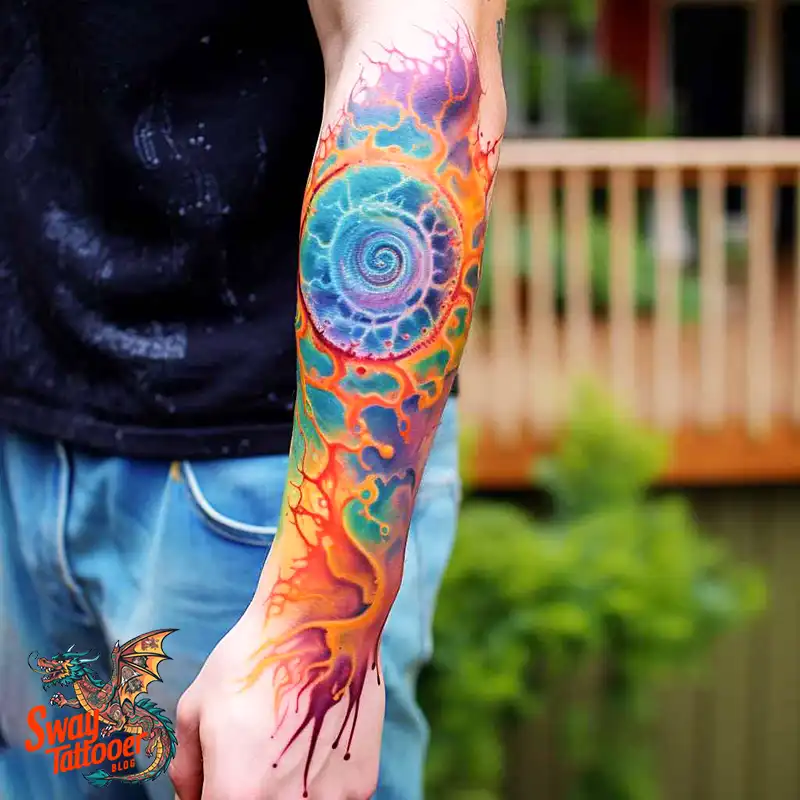
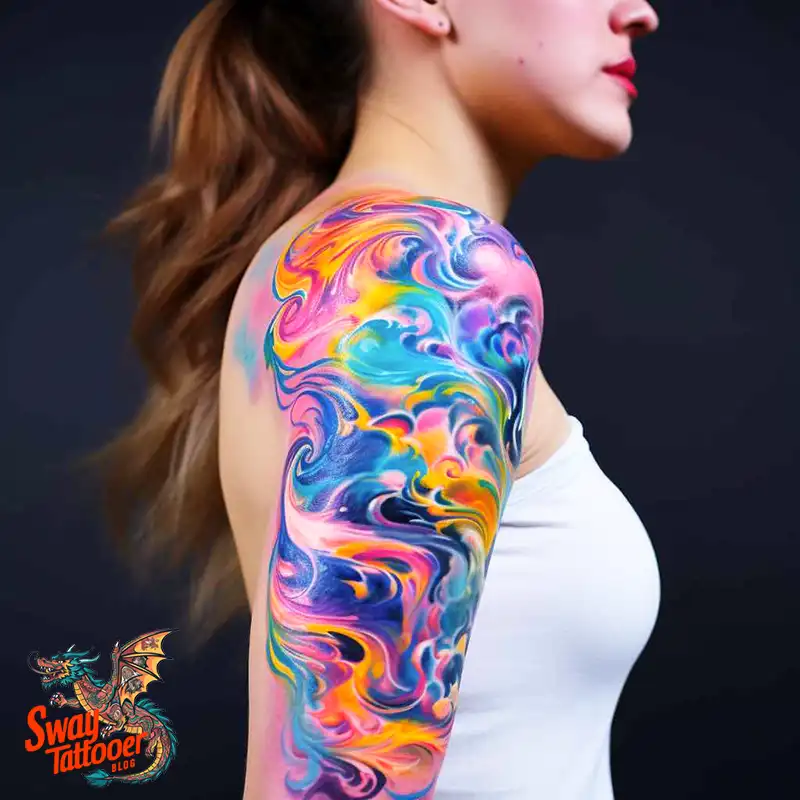
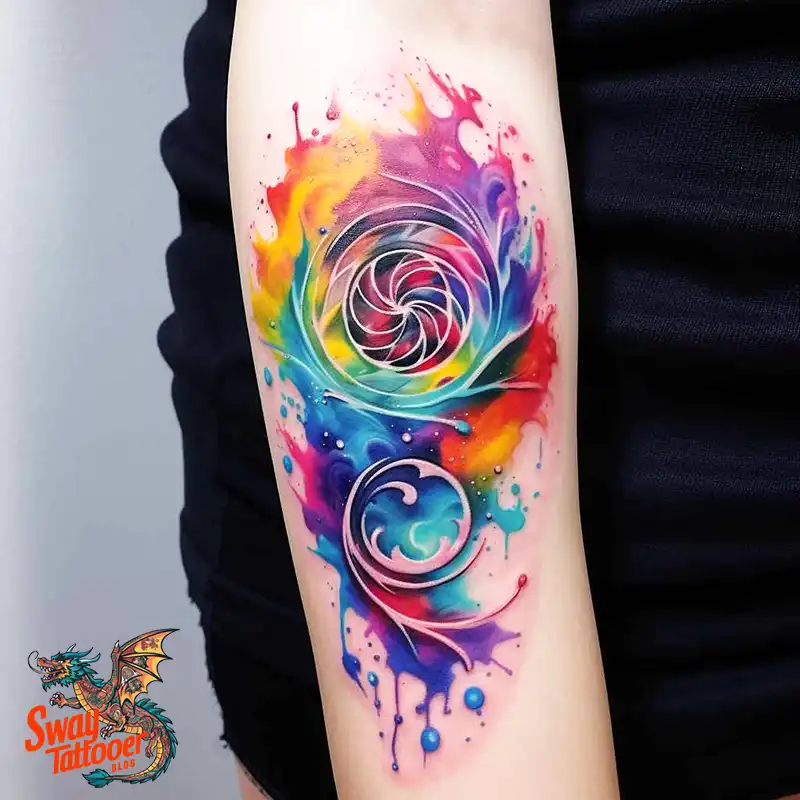
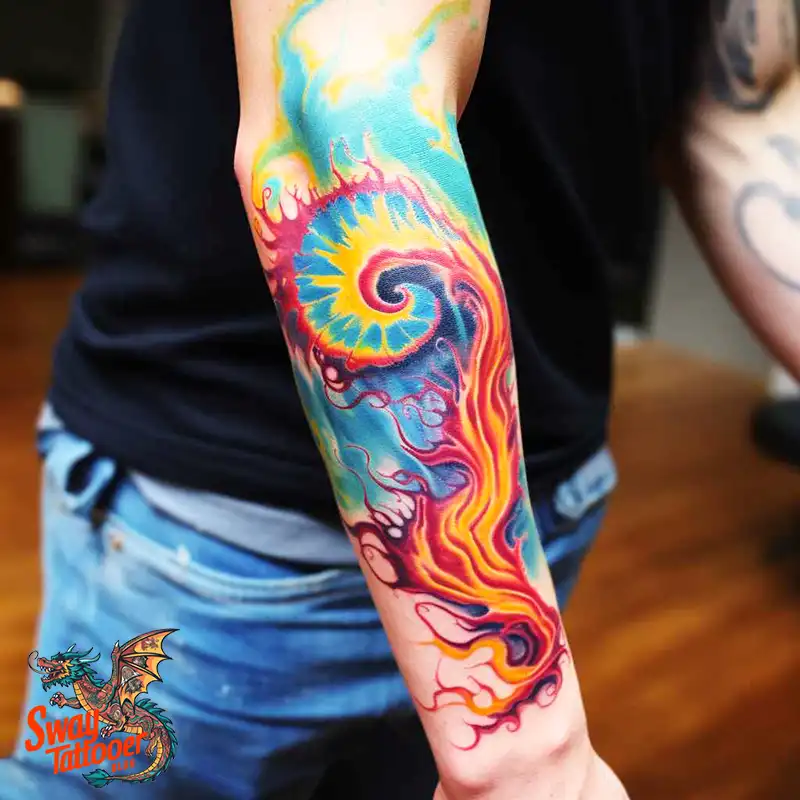
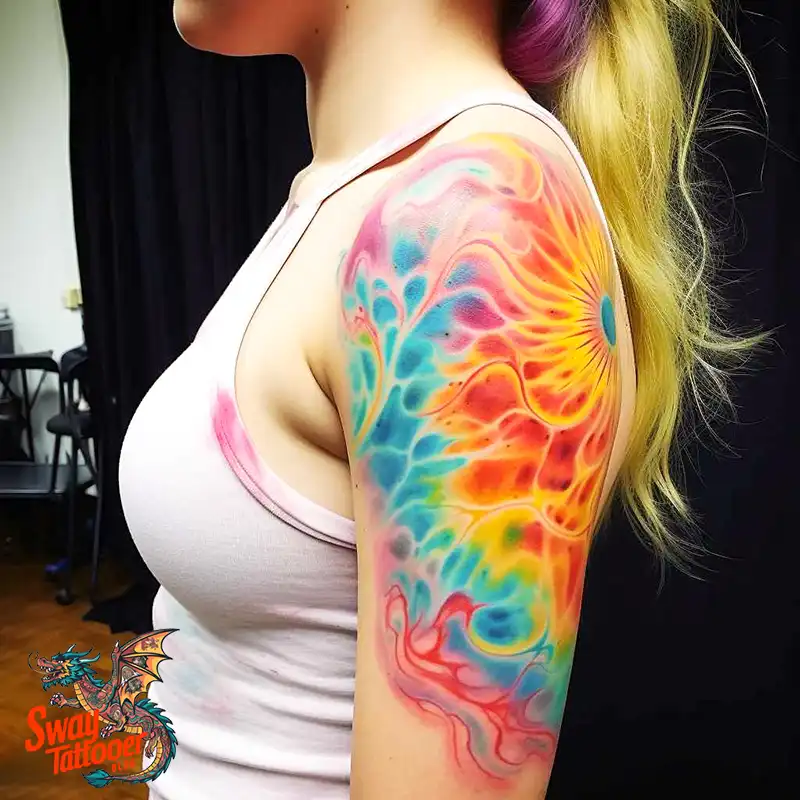

4. Geometric Tie-Dye
Summary:
These tattoos combine shapes such as triangles, hexagons, and other polygons with swirling tie-dye colors within them. The cool part is how the neat shapes and the flowing colors work together to create a fun look.
Why It Matters:
Geometric tie-dye tattoos show a mix of logic and creativity. They are perfect for people who appreciate both order and art. If you’re creative but also like to think things through, this tattoo style fits your personality well.
5. Floral Tie-Dye
Summary:
These tattoos show flowers and plants filled with bright tie-dye colors. The natural shapes of flowers blend with the colorful, flowing patterns of tie-dye.
Why It Matters:
Floral tie-dye tattoos are perfect for individuals who appreciate nature. They stand for growth, life, and the beauty of the natural world. The bright tie-dye colors make these tattoos lively and full of energy. They celebrate the ever-changing beauty of life.
6. Animal Tie-Dye
Summary:
These tattoos feature the outlines of animals, such as butterflies, dolphins, or wolves. Inside the animal shape, tie-dye colors swirl and blend to create the design.
Why It Matters:
Animals often symbolize qualities such as strength, freedom, or wisdom. Adding tie-dye colors makes these tattoos more creative and special. These tattoos are ideal for individuals who feel a connection to certain animals and want a vibrant, distinctive way to express them.
7. Abstract Tie-Dye
Summary:
Abstract tie-dye tattoos don’t show clear pictures. Instead, they have flowing shapes and colors that don’t form a specific image. They’re open to your ideas.
Why It Matters:
These tattoos are for people who like personal meaning and emotional expression. The meaning is up to you. They demonstrate that life is full of surprises and that there is beauty in chaos. Abstract tie-dye tattoos are for those who see life as a blank canvas full of endless possibilities.
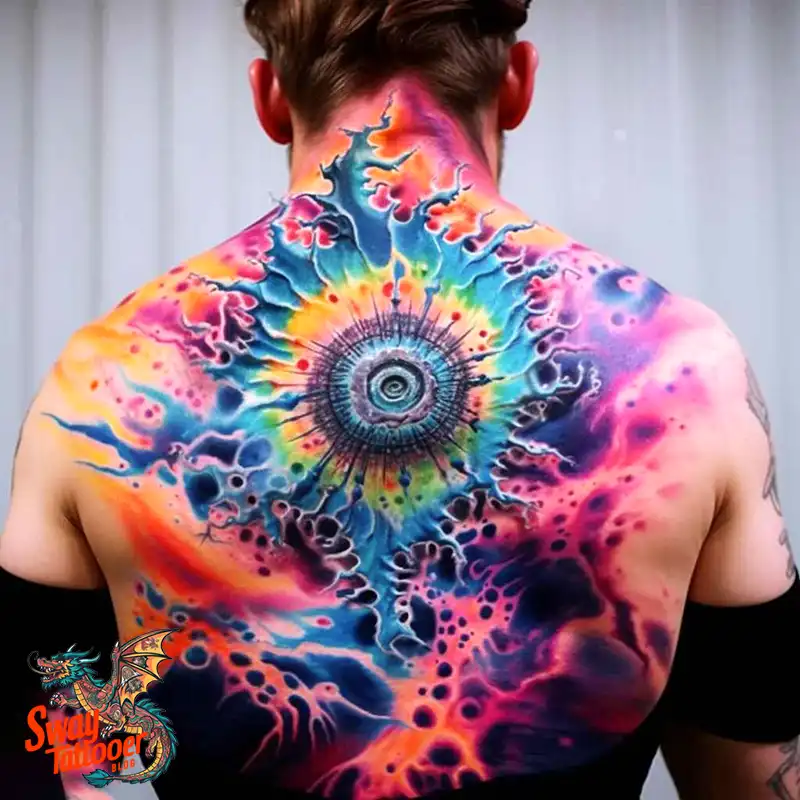
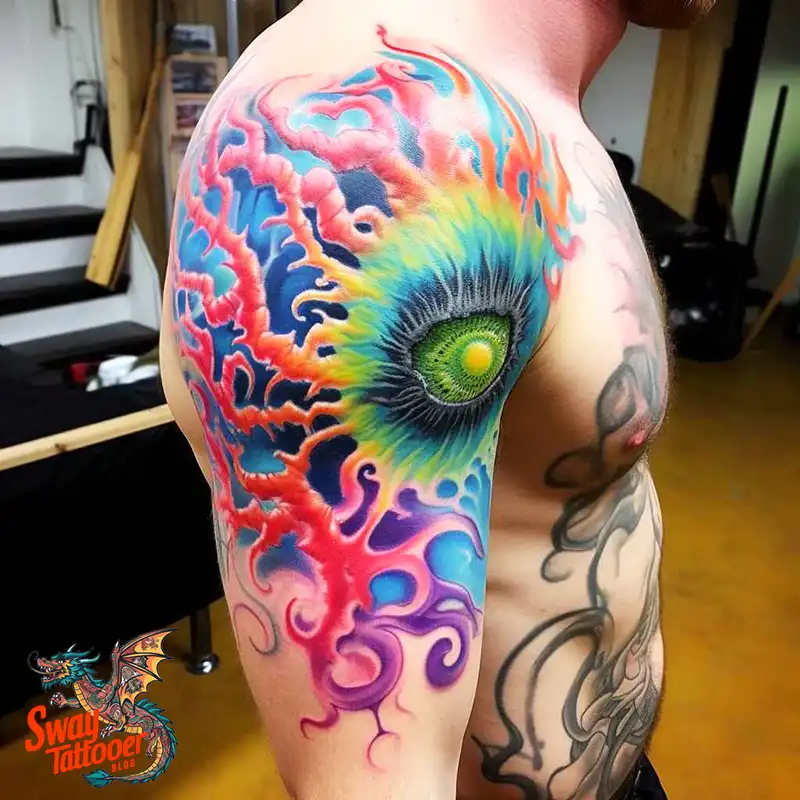

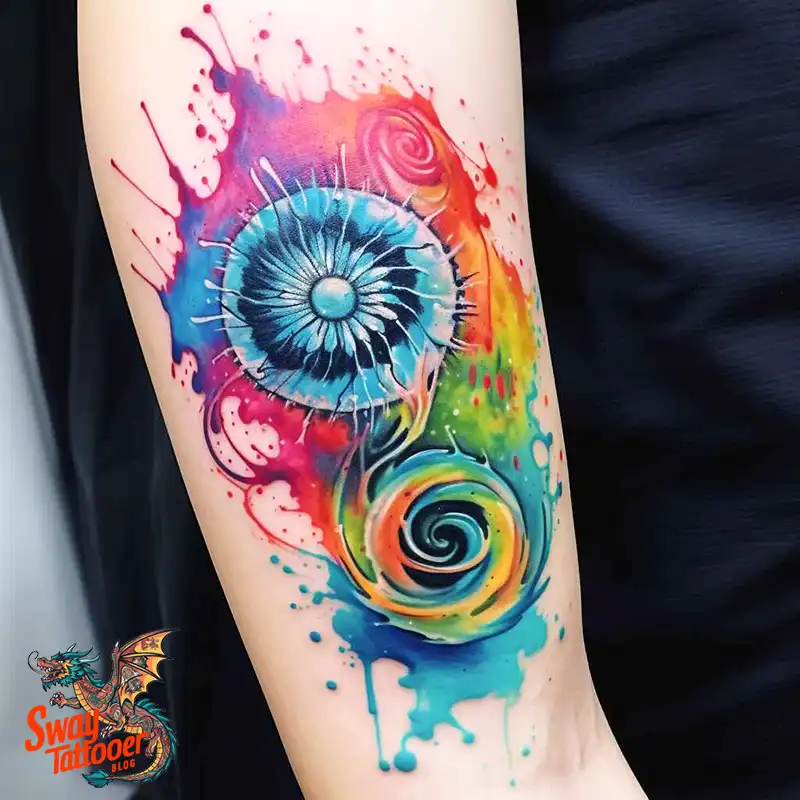

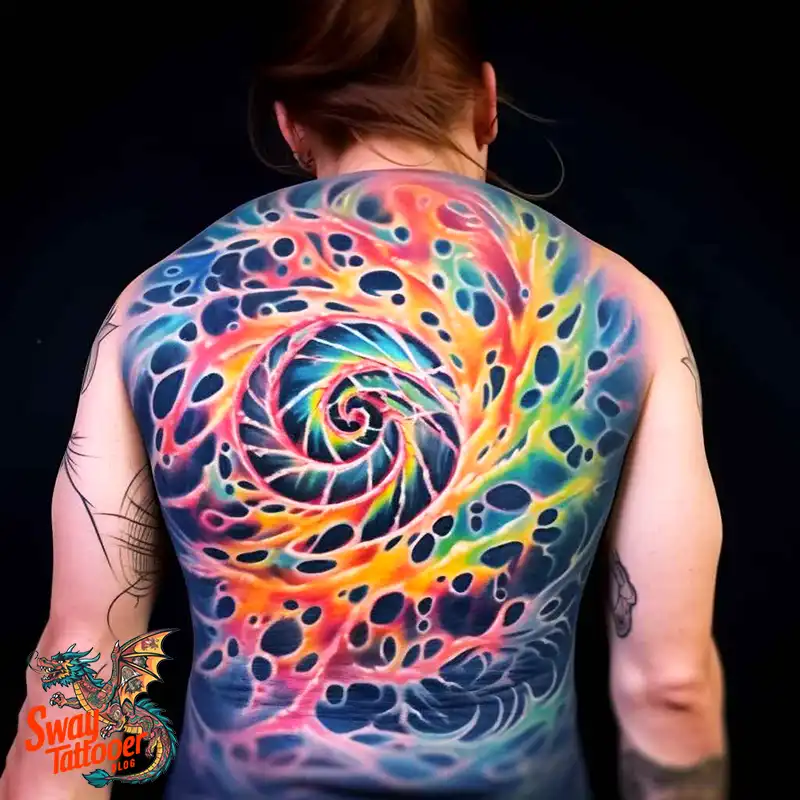

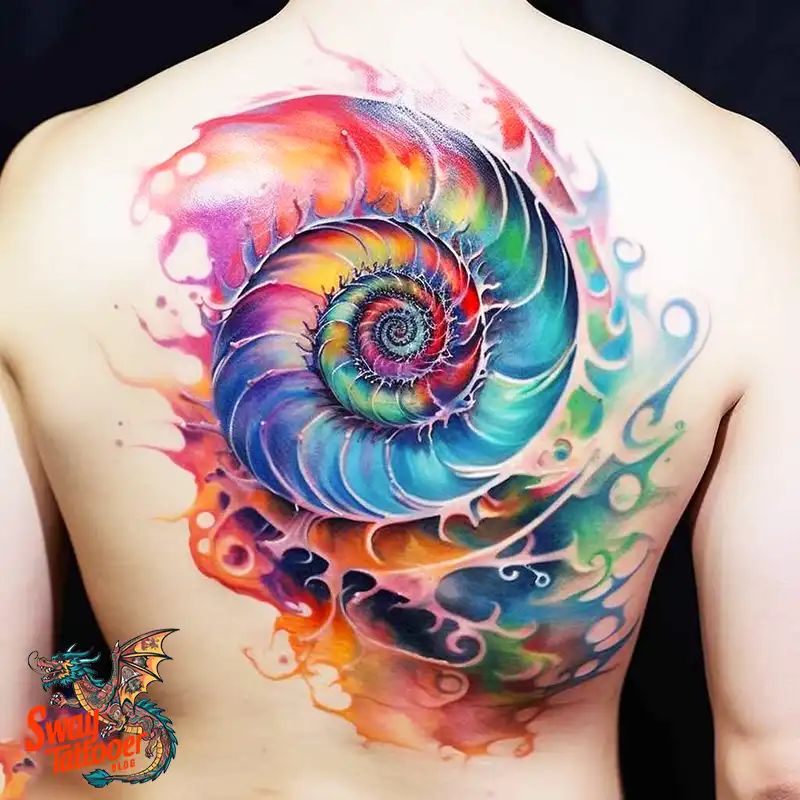
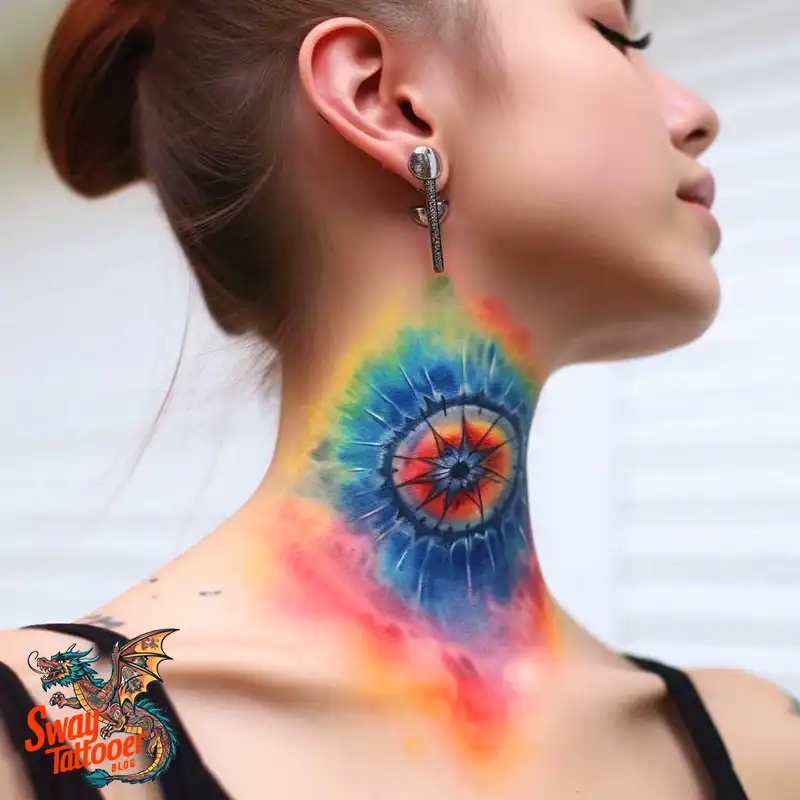
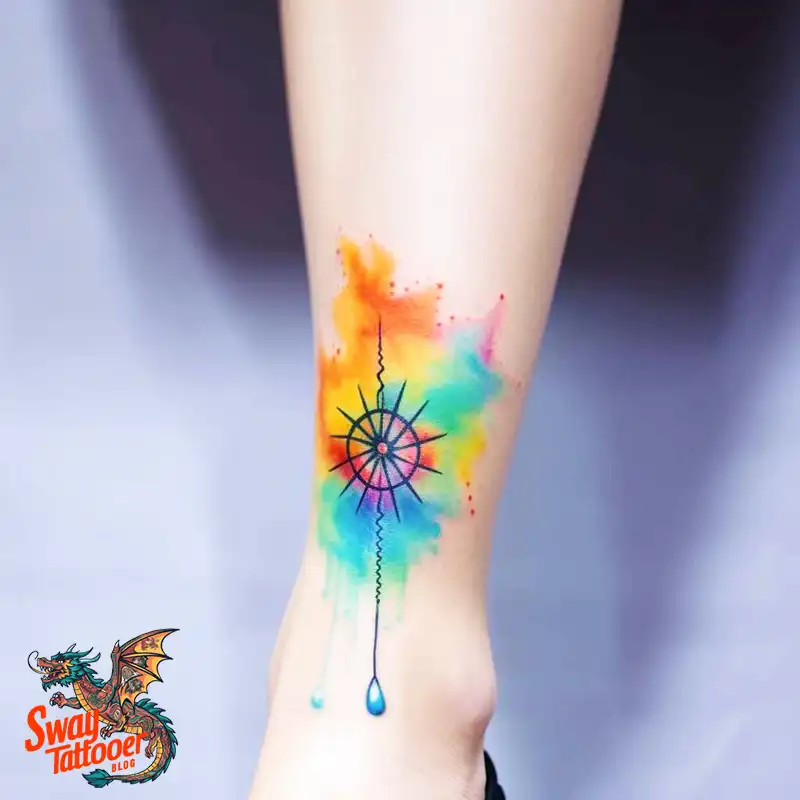


Frequently Asked Questions:
Q1: What is a tie dye tattoo?
A1:
A tie-dye tattoo is bright and colorful, just like the tie-dye patterns of the 1960s. It shows colors swirling and mixing, like on tie-dyed clothes. The result is a fun and eye-catching tattoo that features a variety of colors and shapes, making it truly special.
Q2: How is a tie dye tattoo different from other colorful tattoos?
A2:
Tie-dye tattoos look very different because they try to copy the famous tie-dye pattern. They often feature spirals or round shapes with a smooth blend of many colors. Other colorful tattoos might use one color or soft fades, but tie-dye tattoos resemble fabric dyed with lots of bright colors.
Q3: What colors do tie dye tattoos usually use?
A3:
Tie-dye tattoos feature a wide range of bright colors, including blue, red, yellow, green, purple, and orange. You can pick almost any colors you like, but it’s best to choose ones that look good together to achieve that classic tie-dye look.
Q4: Do tie dye tattoos hurt more than other tattoos?
A4:
Getting a tie dye tattoo hurts about the same as any other tattoo. How much it hurts depends on where the tattoo is, its level of detail, and how much pain you can tolerate. Since tie-dye tattoos use multiple colors and blending techniques, they may take longer and feel uncomfortable for a more extended period.
Q5: How long does it take to get a tie dye tattoo?
A5:
The time it takes depends on the size and detail of your tattoo. Small ones take a few hours. Bigger or more complex tattoos might need more than one session. Since mixing colors and patterns takes time, discuss with your tattoo artist how long the process will take.
Q6: Do tie dye tattoos fade faster than other tattoos?
A6:
Like all tattoos, tie-dye tattoos fade over time because your skin naturally renews itself, and sunlight can also fade the colors. Since tie-dye tattoos often use many bright colors, they may fade more quickly. However, if you take good care of your tattoo—such as keeping it moisturized and out of the sun—the colors will stay vibrant for longer.
Q7: What do I do after getting my new tie dye tattoo?
A7:
Taking care of your new tie-dye tattoo helps it heal properly. Here’s what to do:
- Follow your artist’s care instructions precisely.
- Keep the tattoo clean and use lotion or ointment to moisturize it.
- Avoid direct sunlight and tanning beds. Use sunscreen once your tattoo is fully healed.
- Please refrain from swimming or soaking your tattoo in water until it’s completely healed.
- Avoid picking or scratching your tattoo while it’s healing, as this can lead to scarring or discoloration.
Q8: Are some skin types better for tie dye tattoos, or can anyone get one?
A8:
Anyone can get a tie-dye tattoo, regardless of their skin color. However, colors can appear differently on different skin tones. On light skin, the colors usually look bright and clear. For darker skin, the tattoo artist can adjust the colors and style to create a visually appealing result. It’s a good idea to discuss your skin with your artist so you know how the colors will look after healing.
Q9: How do I choose the right artist for a tie-dye tattoo?
A9:
To achieve a cool tie-dye tattoo, you need the right artist. Here’s what to think about:
- Portfolio: Look at their past work to see if they have done colorful or tie dye tattoos before.
- Style: Ensure their style aligns with your preferences.
- Reputation: Ask people for recommendations and read reviews from their other customers.
- Communication: Pick an artist who listens to your ideas and gives helpful advice.
Q10: Can you cover up or change a tie dye tattoo later?
A10:
Covering or changing a tie-dye tattoo can be tricky due to the multitude of colors and patterns. However, a skilled artist who knows how to create cover-up tattoos can effectively conceal the old design. They will make a new design that blends or covers the old colors. If you want to cover or change your tattoo, talk to an experienced artist for the best advice.
Final Thought
Tie dye tattoos are full of life and color. They stem from a rich history of fabric dyeing and gained popularity in the 1960s, when people sought to express their creativity and freedom.
Creating a tie-dye tattoo is challenging because it requires skill and care to blend colors effectively on the skin. That’s why finding a skilled artist is super important. They make sure your tattoo looks great and stays safe.
Taking care of your tattoo after you get it helps keep the colors bright for a long time.
Tie-dye tattoos showcase your personality and love for art boldly and vibrantly. They mix old traditions with a fresh, modern style. Whether you’ve had tattoos before or this is your first, tie dye tattoos are a fun and creative choice. When you’re ready for your next tattoo, do your research, choose a skilled artist, and enjoy your vibrant new look!


Leave a Reply